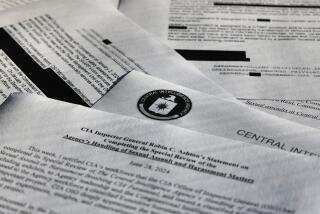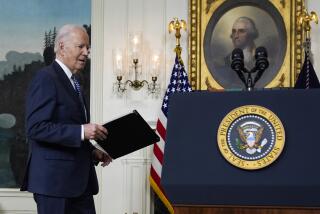Editorial: Time to expose the CIA’s ‘dark side’

More than a year after it approved a report critical of the CIA’s interrogation and detention policies, the Senate Intelligence Committee has voted to make a portion of the document public. It’s now up to President Obama to ensure that the agency doesn’t mount a rear-guard attempt to censor or sanitize the committee’s findings in the name of national security.
Thanks to news reports and a report by the CIA’s inspector general, Americans long have been aware of both the broad outlines and some abhorrent details of the Bush administration’s mistreatment of suspected terrorists after 9/11. We know that suspects were transported for questioning to “black sites” abroad, and that two suspected Al Qaeda operatives, Khalid Shaikh Mohammed and Abu Zubaydah, were subjected to waterboarding. And we have read the memos in which Bush administration lawyers used contorted reasoning to justify torture.
But the Intelligence Committee’s 6,200-word report, based on a review of millions of pages of documents, contains additional accounts of abuse, including (according to a Washington Post report) the alleged repeated dunking of a terrorism suspect in tanks of ice water at a site in Afghanistan. Sen. Dianne Feinstein (D-Calif.), the Intelligence Committee chairwoman who aggressively has sought its declassification, said the report “exposes brutality that stands in stark contrast to our values as a nation.”
More important, those who have read the report say it concludes that waterboarding and other “enhanced interrogation techniques” yielded little valuable intelligence that couldn’t have been obtained by other means. Of course, torture wouldn’t be justifiable even if it “worked”; but if there is evidence that the use of inhumane methods was ineffective as well as immoral, that constitutes another indictment of a policy former Vice President Dick Cheney described as operating on “the dark side.”
Last week the committee voted to declassify the report’s 480-page executive summary along with 20 findings and conclusions, but that represents only the beginning of the disclosure process. The executive branch will now determine which portions of the document must be redacted to protect sensitive national security information.
The Central Intelligence Agency has promised that it will do its part to ensure that the declassification review proceeds “expeditiously.” But the agency complained that a previous version of the report contained serious errors — a charge echoed by the committee’s Republican vice chair — and it has a vested interest in suppressing information that would sully its reputation. That is why the president, who has sent mixed signals about the importance of confronting the abuses of the past, must make thorough and timely declassification of this report a personal priority.
More to Read
A cure for the common opinion
Get thought-provoking perspectives with our weekly newsletter.
You may occasionally receive promotional content from the Los Angeles Times.










